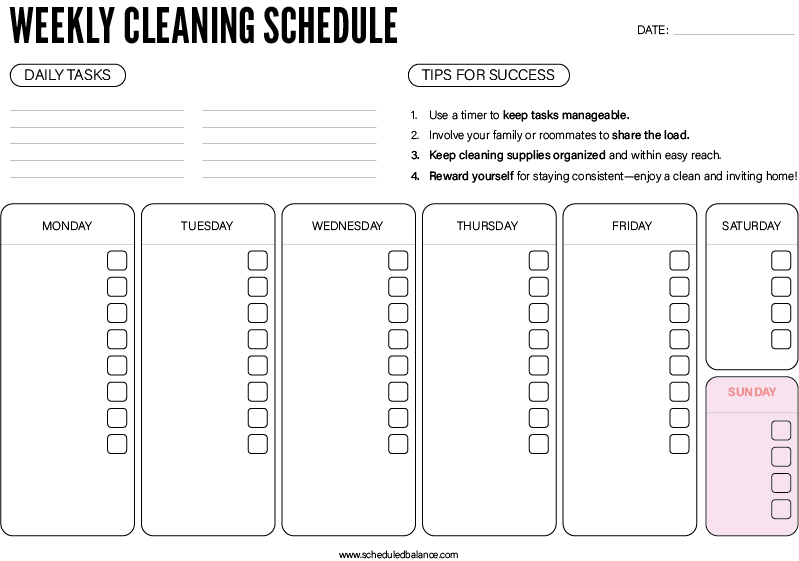Keeping a clean home can feel overwhelming, especially with a busy lifestyle. Between work, school, social activities, and self-care, it often seems like there’s never enough time to stay on top of housework. I was in the same position not too long ago. But over time, I created a weekly cleaning schedule that works for me, helping me maintain a tidy space without feeling stressed.
In this post, I’ll share the key ideas behind building an effective cleaning schedule, the practical steps I took, and the benefits I’ve gained from sticking to it. Whether you’re a busy professional, a student, or someone looking for a cleaner, more organized home, this guide will provide the tools you need to create a cleaning routine that fits your life.
Understanding What Works for You
Before diving into the practical steps of creating a weekly cleaning schedule, it’s essential to first understand what will work for you. Every home, lifestyle, and routine is different. Here’s how I approached this crucial first step:
- Assess Your Space and Needs: The first thing I did was assess my living space. My home is not huge, but I also don’t want to spend hours cleaning every week. Identifying the areas that get the dirtiest and need the most attention was key. For example, my kitchen and bathroom require cleaning more frequently than my guest room.
- Consider Your Routine and Energy Levels: I’ve learned that I feel most energized in the mornings, so I tackle my more intense cleaning tasks early in the day. If you’re more of an evening person, you might schedule your cleaning tasks for later.
- Prioritize Consistency Over Perfection: When creating my schedule, I focused on building consistency rather than trying to achieve a spotless home every day. Perfection isn’t the goal—it’s about creating a routine that keeps your home clean without adding unnecessary stress.
- Incorporate Daily Maintenance: I don’t save all the cleaning for one big day of the week. Instead, I do small tasks every day, like wiping down counters or tidying up. This has made a huge difference in keeping my home tidy and preventing overwhelming cleaning days.
Creating a Weekly Cleaning Schedule That Works
Now that I’ve covered the foundation for creating a cleaning schedule that fits your needs, let’s dive into the specific steps I took to build my own cleaning routine.
Step 1: Break Down Your Cleaning Tasks
I started by breaking down the cleaning tasks that needed to be done weekly. This helped me create a more manageable routine. Here’s a list of tasks I include:
- Daily Tasks:
- Wipe down kitchen surfaces (countertops, stove, sink).
- Tidy up living areas (put away items, fluff cushions).
- Quick sweep of high-traffic areas (hallways, entryways).
- Weekly Tasks:
- Vacuum and mop the floors.
- Clean bathrooms (toilets, sinks, mirrors).
- Dust surfaces (shelves, windowsills).
- Clean kitchen appliances (microwave, fridge, oven).
- Change bed linens.
- Deep Cleaning Tasks (Every 2-4 Weeks):
- Clean baseboards and corners.
- Wash windows.
- Clean behind and under furniture.
Step 2: Assign Days for Specific Tasks

Once I had a list of tasks, I divided them by days of the week. I wanted to keep my cleaning schedule flexible while also ensuring I wasn’t doing everything on the same day. Here’s an example of what my weekly cleaning schedule looks like:
- Monday: Vacuum and mop floors (focus on bedrooms and living areas).
- Tuesday: Clean the bathroom (toilet, sink, mirrors).
- Wednesday: Dust all surfaces in the living room and kitchen.
- Thursday: Deep clean kitchen appliances (microwave, oven, fridge).
- Friday: Change bed linens and tidy up living areas.
- Saturday: Deep cleaning (focus on corners, windows, or behind furniture).
- Sunday: Relax! Light tidying only.
Step 3: Set Realistic Time Blocks
Next, I allocated time for each task based on how long I thought it would take. I set timers to keep myself on track and avoid spending more time than necessary on any one task. For example:
- 15-20 minutes for wiping down the kitchen and tidying up.
- 30 minutes for bathroom cleaning.
- 1 hour for deep cleaning.
Adjusting the time as I went along helped me stay realistic and prevent burnout. I knew if a task took longer than expected, I could shift it to the next day.
Step 4: Stay Flexible and Adjust as Needed
Life happens! There will be days when I can’t stick to my plan, whether because of work commitments, errands, or social activities. I learned to be flexible with my schedule. If I didn’t get a task done one day, I simply moved it to the next.
Benefits: How This Cleaning Schedule Changed My Life
Now that I’ve followed my cleaning schedule for several months, I’ve noticed several positive changes in my life. Here are the top benefits of having a weekly cleaning schedule:
- Less Stress: Knowing that I have a plan for cleaning each week has significantly reduced the stress that comes with a cluttered space. I no longer have to spend an entire Saturday cleaning—it’s all broken down into manageable tasks.
- More Free Time: By setting aside small chunks of time each day, I’ve created more free time for hobbies, relaxation, and spending time with loved ones. Cleaning no longer dominates my weekend.
- A Consistently Clean Home: Because I stay consistent with my schedule, my home is always in good shape. I no longer have to deal with that overwhelming feeling of a messy space.
- Improved Focus and Productivity: A clean environment has a direct impact on my productivity. When my home is tidy, I can focus better on work and personal projects without distractions.
In Conclusion…
Creating a weekly cleaning schedule that works for me has been a game changer. It allows me to maintain a clean home without feeling overwhelmed, and the benefits have extended beyond cleanliness to better mental clarity and more free time.
Now that you’ve seen how I’ve structured my cleaning routine, I encourage you to create one that works for your lifestyle. Download my Weekly Cleaning Schedule Checklist to get started!
